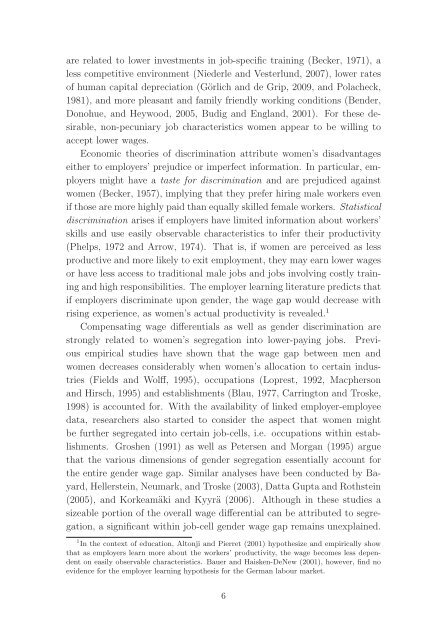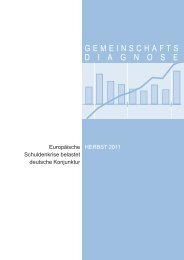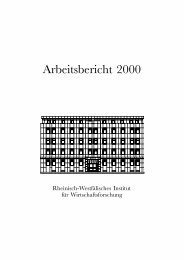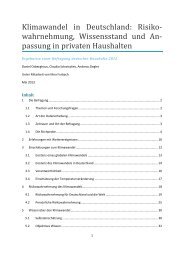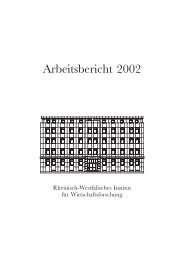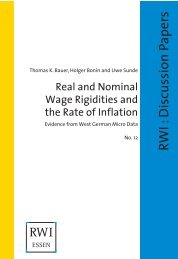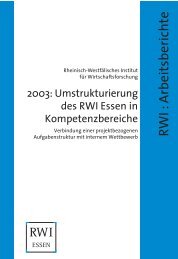Gender Segregation and Gender Wage Differences during the Early ...
Gender Segregation and Gender Wage Differences during the Early ...
Gender Segregation and Gender Wage Differences during the Early ...
Create successful ePaper yourself
Turn your PDF publications into a flip-book with our unique Google optimized e-Paper software.
are related to lower investments in job-specific training (Becker, 1971), a<br />
less competitive environment (Niederle <strong>and</strong> Vesterlund, 2007), lower rates<br />
of human capital depreciation (Görlich <strong>and</strong> de Grip, 2009, <strong>and</strong> Polacheck,<br />
1981), <strong>and</strong> more pleasant <strong>and</strong> family friendly working conditions (Bender,<br />
Donohue, <strong>and</strong> Heywood, 2005, Budig <strong>and</strong> Engl<strong>and</strong>, 2001). For <strong>the</strong>se desirable,<br />
non-pecuniary job characteristics women appear to be willing to<br />
accept lower wages.<br />
Economic <strong>the</strong>ories of discrimination attribute women’s disadvantages<br />
ei<strong>the</strong>r to employers’ prejudice or imperfect information. In particular, employers<br />
might have a taste for discrimination <strong>and</strong> are prejudiced against<br />
women (Becker, 1957), implying that <strong>the</strong>y prefer hiring male workers even<br />
if those are more highly paid than equally skilled female workers. Statistical<br />
discrimination arises if employers have limited information about workers’<br />
skills <strong>and</strong> use easily observable characteristics to infer <strong>the</strong>ir productivity<br />
(Phelps, 1972 <strong>and</strong> Arrow, 1974). That is, if women are perceived as less<br />
productive <strong>and</strong> more likely to exit employment, <strong>the</strong>y may earn lower wages<br />
or have less access to traditional male jobs <strong>and</strong> jobs involving costly training<br />
<strong>and</strong> high responsibilities. The employer learning literature predicts that<br />
if employers discriminate upon gender, <strong>the</strong> wage gap would decrease with<br />
rising experience, as women’s actual productivity is revealed. 1<br />
Compensating wage differentials as well as gender discrimination are<br />
strongly related to women’s segregation into lower-paying jobs. Previous<br />
empirical studies have shown that <strong>the</strong> wage gap between men <strong>and</strong><br />
women decreases considerably when women’s allocation to certain industries<br />
(Fields <strong>and</strong> Wolff, 1995), occupations (Loprest, 1992, Macpherson<br />
<strong>and</strong> Hirsch, 1995) <strong>and</strong> establishments (Blau, 1977, Carrington <strong>and</strong> Troske,<br />
1998) is accounted for. With <strong>the</strong> availability of linked employer-employee<br />
data, researchers also started to consider <strong>the</strong> aspect that women might<br />
be fur<strong>the</strong>r segregated into certain job-cells, i.e. occupations within establishments.<br />
Groshen (1991) as well as Petersen <strong>and</strong> Morgan (1995) argue<br />
that <strong>the</strong> various dimensions of gender segregation essentially account for<br />
<strong>the</strong> entire gender wage gap. Similar analyses have been conducted by Bayard,<br />
Hellerstein, Neumark, <strong>and</strong> Troske (2003), Datta Gupta <strong>and</strong> Rothstein<br />
(2005), <strong>and</strong> Korkeamäki <strong>and</strong> Kyyrä (2006). Although in <strong>the</strong>se studies a<br />
sizeable portion of <strong>the</strong> overall wage differential can be attributed to segregation,<br />
a significant within job-cell gender wage gap remains unexplained.<br />
1 In <strong>the</strong> context of education, Altonji <strong>and</strong> Pierret (2001) hypo<strong>the</strong>size <strong>and</strong> empirically show<br />
that as employers learn more about <strong>the</strong> workers’ productivity, <strong>the</strong> wage becomes less dependent<br />
on easily observable characteristics. Bauer <strong>and</strong> Haisken-DeNew (2001), however, find no<br />
evidence for <strong>the</strong> employer learning hypo<strong>the</strong>sis for <strong>the</strong> German labour market.<br />
6


